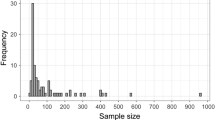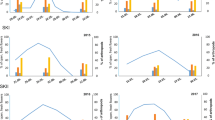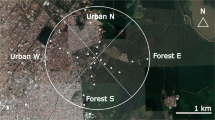Abstract
An unusual pollination strategy is pollination by sexual deception in which orchids sexually attract male insects as pollinators. One gap in knowledge concerns the pattern and extent of pollinator movement among these sexually deceptive flowers and how this translates to pollen and gene flow. Our aim was to use mark and recapture techniques to investigate the behavior and movement of male Colletes cunicularius, an important bee pollinator of Ophrys. Our study site was located in northern Switzerland where a large population of the bees was nesting. Within two plots, (10×40 m), we marked bees with different colors and numbered tags. Seventeen percent of the 577 marked bees were recaptured over a period of 1 to a maximum of 11 days. However, the number of recaptures dropped dramatically after 3–5 days, suggesting an average lifetime of less than 10 days. Mark-recapture distances varied from 0 to 50 m, with a mean of 5 m. Our findings show that individual male bees patrol a specific and restricted region of the nesting area in search of mates. This mark-recapture study provides the first clues about the potential movement of pollen within populations of Ophrys orchids. We predict that orchid-pollen movements mediated by bees will be similar to the mark-recapture distances in this study. Parallel studies within orchid populations, including direct studies of pollen movement, are now required to better understand how pollinator mate-searching behavior translates to pollination success and pollen movement within sexually deceptive orchid populations.



Similar content being viewed by others
References
Ackerman JD (1986) Mechanisms and evolution of food deceptive pollination systems in orchids. Lindleyana 1:108–113
Alcock J, Barrows EM, Gordh G, Hubbard LJ, Kirkendall L, Pyle DW, Ponder TL, Zalom FG (1978) Ecology and evolution of male reproductive-behavior in the bees and wasps. Zool J Linn Soc 64:293–326
Ayasse M, Schiestl FP, Paulus HF, Löfstedt C, Hansson BS, Ibarra F, Francke W (2000) Evolution of reproductive strategies in the sexually deceptive orchid Ophrys sphegodes: how does flower-specific variation of odor signals influence reproductive success? Evolution 54:1995–2006
Ayasse M, Paxton RJ, Tengö J (2001) Mating behavior and chemical communication in the order Hymenoptera. Annu Rev Entomol 46:31–78
Batra SWT (1980) Ecology, behavior, pheromones, parastites and management of the sympatric vernal bees Colletes inaequalis, C. thoracicus and C. validus. J Kans Entomol Soc 53:509–538
Borg-Karlson A, Tengo J, Valterova I, Unelius CR, Taghizadeh T, Tolasch T, Francke W (2003) (S)-(+)-Linalool, a mate attractant pheromone component in the bee Colletes cunicularius. J Chem Ecol 29:1–14
Butler CG (1965) Sex attraction in Andrena flavipes Panzer, with some observations on nest-site restriction. Proc R Entomol Soc Lond Ser A 40:77–80
Cane JH, Tengö JO (1981) Pheromonal cues direct mate-seeking behavior of male Colletes cunicularius (Hymenoptera: Colletidae). J Chem Ecol 7:427–436
Dafni A (1984) Mimicry and deception in pollination. Annu Rev Ecol Syst 15:259–278
Dressler RL (1981) The orchids natural history and classification. Harvard University Press, Cambridge
Eickwort GC, Ginsberg HS (1980) Foraging and mating in Apoidea. Annu Rev Entomol 25:421–446
Gill DE (1989) Fruiting failure, pollinator inefficiency, and speciation in orchids. In: Otte D, Endler JA (eds) Speciation and its consequences. Sinauer, Sunderland, pp 458–481
Haas A (1960) Vergleichende Verhaltensstudien zum Paarungsschwarm solitärer Apiden. Z Tierpsychol 17:402–416
Kullenberg B (1961) Studies in Ophrys pollination. Zool Bidr Uppsala 34
Kullenberg B, Borg-Karlson AK, Kullenberg AZ (1984) Field studies on the behaviour of Eucera nigrilabris male in the odour flow from flower labellum extract of Ophrys tenthredinifera. Nova Acta Regiae Soc Sci Ups Ser V:79–110
Neiland MRM, Wilcock CC (1995) Maximisation of reproductive success by European Orchidaceae under conditions of infrequent pollination. Protoplasma 187:39–48
Nilsson LA (1992) Orchid pollination biology. TREE 7:255–259
Paulus HF, Gack C (1990) Pollinators as prepollinating isolation factors: evolution and speciation in Ophrys (Orchidaceae). Isr J Bot 39:43–79
Peakall R (1989) A new technique for monitoring pollen flow in orchids. Oecologia 79:361–365
Peakall R (1990) Responses of male Zaspilothynnus trilobatus wasps to females and the sexually deceptive orchid it pollinates. Funct Ecol 4:159–167
Peakall R, Beattie AJ (1996) Ecological and genetic consequences of pollination by sexual deception in the orchid Caladenia tentaculata. Evolution 50:2207–2220
Richards AJ (1997) Plant breeding systems, 2nd edn. Chapman and Hall, London
Schiestl FP, Ayasse M, Paulus HF, Löfstedt C, Hansson BS, Ibarra F, Francke W (1999) Orchid pollination by sexual swindle. Nature 399:421–422
SchiestlFP, PeakallR, Mant JM, Ibarra F, Schulz C, Franke S, Francke W (2003) Science 302 437–438
Tengö J (1979) Odour-released behaviour in Andrena male bees (Apoidea, Hymenoptera). Zoon 7 15–48
Warncke K, Kullenberg B (1984) Übersicht von Beobachtungen über Besuche von Andrena- und Colletes cunicularius-Männchen auf Ophrys-Blüten (Orchidaceae). Nova Acta Regiae Soc Sci Ups Ser V:C 3:41–55
Westrich P (1989) Die Wildbienen Baden Württembergs. Eugen Ulmer, Stuttgart
Acknowledgements
This study was made possible by a Swiss National Foundation visiting scientist stipend to R.P. (PIOIC-101323/3A) and the generosity of the Geobotanical Institute, ETH, Zurich, who kindly hosted his visit. We also thank Andreas Müller (Zürich) and Egon Knapp (Neuhausen) for advice on the local bee populations . Col Bower and two anonymous referees provided helpful comments on the manuscript. The experiments conducted in this study comply with current Swiss law.
Author information
Authors and Affiliations
Corresponding author
Additional information
Communicated by R.F.A. Moritz
Rights and permissions
About this article
Cite this article
Peakall, R., Schiestl, F.P. A mark-recapture study of male Colletes cunicularius bees: implications for pollination by sexual deception. Behav Ecol Sociobiol 56, 579–584 (2004). https://doi.org/10.1007/s00265-004-0816-3
Received:
Revised:
Accepted:
Published:
Issue Date:
DOI: https://doi.org/10.1007/s00265-004-0816-3




